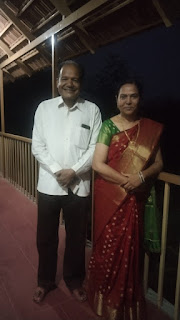Akira Miyawaki Forest blooming at Battis Shirala
Akira Miyawaki Forest blooming at Battis Shirala
Battis Shirala, Sangli District, August 2- A doctor couple of Battis Shirala in Sangli district has developed a unique forest within just one year using a technique evolved by Japanese botanist Akira Miyawaki. The physician, Dr Nitin Jadhav and his gynaecologist wife, Dr Krushna, of the Anand Hospital, have completed the first year of the project on July five last. They have celebrated the first anniversary of the man-made forest.
The forest has come up at the hitherto barren 8000 square feet (eight guntha) plot at Sidhivinayak Nagar with the help of the team Planet Earth Foundation, India (PEF), an NGO based at Battis Shirala. (eight guntha) plot at Sidhivinayak Nagar with the help of the team Planet Earth Foundation, India (PEF), an NGO based at Battis Shirala.
The Miyawaki Forest Development Technique has won world-wide recognition to contribute in reducing carbon footprints. This technique can raise a dense forest within just two years to raise flora and fauna that would normally require ten years for the regular plantation method, says Mr Akash Patil, the President of PEF.
Pimpal, Umbar, Wad, Payar are some of the ficus species; Jambhal, Rai Jambhal, Karanj, Amba, Fanas among the wild fruiting species; Tamhan, Kanchan, Bahava, Palas, Kate Sawar are the wild flowering species; Behada, Hirda, Ritha, Awala, Kadulimb and Kadipatta are some medicinal species of trees planted in this forest during the year gone by.
·The PEF team started working with the soil preparation with the earth moving machines and labours. It took 20 days to move one-meter deep soil out from the entire plot and replace it by mixing with ingredients like cow dung, rice husk and sugarcane husk etc.
· The plantation bed was ready by mid-June 2019.
·The team started the plantation in the first week of July with volunteers from Shirala and internsof forestry and Environmental Science courses
· The volunteers spread the locally-available mulch of rice sticks and gave support to all the saplings.
·The PEF Team and Dr Jadhav family started a weekly and monthly monitoring and maintenance system. Watering the plants and removing the weed were the important regular tasks.
Plan for 2020-21: The PEF volunteers have collected seeds of 25 different native plant species from the Shirala block. They will establish a nursery of native species in the project area. The team will be able to provide saplings for people the next year.
The response so far: By the first month after the inauguration of the forest, over 2000 people have visited the project and appreciated the growth of the forest. Many have got inspired from this project and started planting trees and taking care of existing large trees in their areas, says Pranav Mahajan, the Vice-President of PEF.
The Project team members and volunteers are happy to contribute to Mother Nature through this project. The focus is to plant a native sapling and conserve one large tree in your area. They have begun creating awareness to grow own forests through this unique method.
nitin_krishnaj@rediffmail.com
--
You are welcome to use this information above and photographs below for your news, features and blogs. We will appreciate if you give credit to this blog, Dr Nitin Jadhav or the Planet Earth Foundation, India
Prof Dr Kiran Thakur
Professor, Emeritus
Director
Center
of Communication for Development
Department
of Journalism and Mass Communication.
Vishwakarma
University, Pune
kiran.thakur@vupune.ac.in
drkiranthakur@gmail.com
--
Dr Nitin Jadhav
Dr Krushna Jadhav
Birds recorded at our forest during the first year:

 |
| Common Hoopoe |
 |
| Spotted Owlet |
 |
| Indian Peafowl (Female) |
 |
| Purple Sunbird |
 |
| Brahminy Starling |
 |
| Asian Koel |
 |
| Purple Sunbird |
--
Author of this blogpost:
Dr Kiran Thakur
Professor Emeritus








Comments
Post a Comment